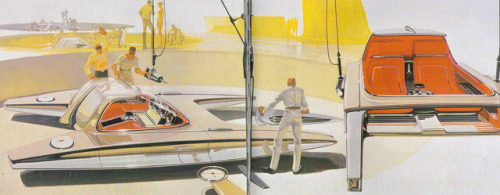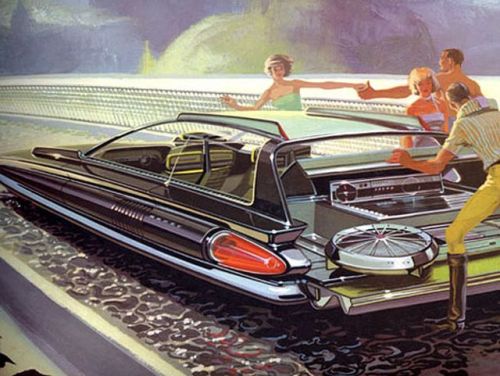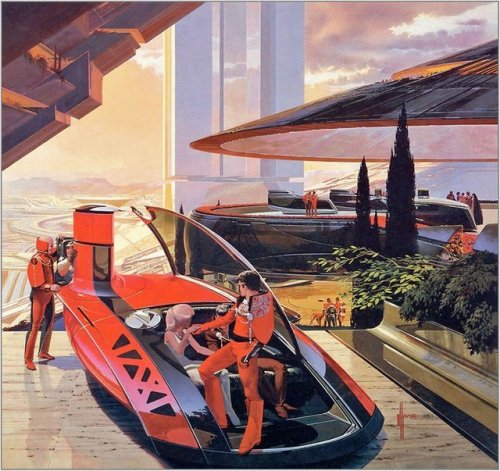Gglennw - Untitled
More Posts from Gglennw and Others
Here’s What Actually Happens Inside Our Lunar Lab
Water is a precious resource – especially on the Moon! In the near future, robotic rovers may roam the Moon’s poles in search of hidden reservoirs of water beneath the lunar surface. But traversing the poles can be a perilous journey. Depending on the Sun’s position in the sky and the way that its light falls on the surface, hazards such as boulders and craters can be difficult, if not impossible, to see.

Inside our Lunar Lab at Ames Research Center, researchers are using Hollywood light kits and a giant sandbox filled with 8 tons of artificial Moon dirt to simulate driving conditions at the poles. The research aims to provide rovers and their human supervisors with 3-D hazard maps of the Moon’s terrain, helping them to avoid potential obstacles that lie ahead.
Here’s how it works:
STEP 1: GENERATE A MOON MAP

Researchers begin with a map of the Moon’s terrain that’s randomly generated by a computer, based on real orbital data. The map indicates the number, location and size of features like rocks and craters that should be placed inside the 12x12-foot testbed.
STEP 2: BUILD A MOONSCAPE

Using the map as a guide, researchers build the terrain by hand with everyday tools. The terrain is then dusted with a top layer of artificial Moon dirt to eliminate shovel and brush marks.
STEP 3: CAPTURE IMAGES

Lights are positioned at different locations around the testbed. One by one, the lights are switched on and off while a camera captures images of the terrain. Notice how the appearance of the terrain changes depending on the source of illumination.
STEP 4: CREATE A 3-D MODEL

Using a computer algorithm, a 3-D hazard detection model of the terrain is generated from the images. The model provides important information about the size of an obstacle, its height and where it’s located.
STEP 5: GO EXPLORING

With this technique, researchers can teach a rover to recognize the effect of different lighting conditions on the Moon’s poles. The tool could come in handy for future lunar rover missions like Resource Prospector, which will use a drill to search for subsurface water and other compounds on the Moon.
Make sure to follow us on Tumblr for your regular dose of space: http://nasa.tumblr.com






Giclée Art Prints By Archan Nair
*More Things & Stuff





The Martian Chronicles (1979) Original artwork by Ian Miller.
Milestone Nine
It’s International Asteroid Day!
There are more than 700,000 known asteroids, but how much do you know about these rocky remnants left over from the birth of our solar system 4.6 billion years ago?

Today, June 30 is International Asteroid Day. Here are some things to know about our fascinating space rubble.
1. A Place in Space
Asteroids—named by British astronomer William Herschel from the Greek expression meaning “star-like"—are rocky, airless worlds that are too small to be called planets. But what they might lack in size they certainly make up for in number: An estimated 1.1 to 1.9 million asteroids larger than 1 kilometer are in the Main Belt between the orbits of Mars and Jupiter. And there are millions more that are smaller in size. Asteroids range in size from Vesta—the largest at about 329 miles (529 kilometers) wide—to bodies that are just a few feet across.

2. What Lies Beneath
Asteroids are generally categorized into three types: carbon-rich, silicate, or metallic, or some combination of the three. Why the different types? It all comes down to how far from the sun they formed. Some experienced high temperatures and partly melted, with iron sinking to the center and volcanic lava forced to the surface. The asteroid Vesta is one example we know of today.
3. Small Overall
If all of the asteroids were combined into a ball, they would still be much smaller than the Earth’s moon.
4. Except for a Big One
In 1801, Giuseppe Piazzi discovered the first and then-largest asteroid, Ceres, orbiting between Mars and Jupiter. Ceres is so large that it encompasses about one-fourth of the estimated total mass of all the asteroids in the asteroid belt. In 2006, its classification changed from asteroid to as a dwarf planet.

5. Mission to a Metal World
NASA’s Psyche mission will launch in 2022 to explore an all-metal asteroid—what could be the core of an early planet—for the very first time. And in October 2021, the Lucy mission will be the first to visit Jupiter’s swarms of Trojan asteroids.

6. Near-Earth Asteroids
The term ‘near’ in near-Earth asteroid is actually a misnomer; most of these bodies do not come close to Earth at all. By definition, a near-Earth asteroid is an asteroid that comes within 28 million miles (44 million km) of Earth’s orbit. As of June 19, 2017, there are 16,209 known near-Earth asteroids, with 1,803 classified as potentially hazardous asteroids (those that could someday pose a threat to Earth).
7. Comin’ in Hot
About once a year, a car-sized asteroid hits Earth’s atmosphere, creates an impressive fireball, and burns up before reaching the surface.
8. But We’re Keeping an Eye Out
Ground-based observatories and facilities such as Pan-STARRS, the Catalina Sky Survey, and ATLAS are constantly on the hunt to detect near-Earth asteroids. NASA also has a small infrared observatory in orbit about the Earth: NEOWISE. In addition to detecting asteroids and comets, NEOWISE also characterizes these small bodies.

9. Buddy System
Roughly one-sixth of the asteroid population have a small companion moon (some even have two moons). The first discovery of an asteroid-moon system was of asteroid Ida and its moon Dactyl in 1993.
10. Earthly Visitors

Several NASA space missions have flown to and observed asteroids. The NEAR Shoemaker mission landed on asteroid Eros in 2001 and NASA’s Dawn mission was the first mission to orbit an asteroid in 2011. In 2005, the Japanese spacecraft Hayabusa landed on asteroid Itokawa. Currently, NASA’s OSIRIS-REx is en route to a near-Earth asteroid called Bennu; it will bring a small sample back to Earth for study.
Make sure to follow us on Tumblr for your regular dose of space: http://nasa.tumblr.com






Six covers by Bob Pepper.
Via Ragged Claws





“I’ve been trying to get rid of wheels since 1963” -Syd Mead
Great research opportunity
The solar maximum in cycle 24 was oddly smooth yet, had
Solar System: Things to Know This Week
Mark your calendars for summer 2018: That’s when we’re launching a spacecraft to touch the sun.
In honor of our first-ever mission to the heart of the solar system, this week we’re delving into the life and times of this powerful yellow dwarf star.

1. Meet Parker
Parker Solar Probe, our first mission to go to the sun, is named after Eugene Parker, an American astrophysicist who first theorized that the sun constantly sends out a flow of particles and energy called the solar wind. This historic mission will explore one of the last regions of the solar system to be visited by a spacecraft and help scientists unlock answers to questions they’ve been pondering for more than five decades.

2. Extra SPF, Please
Parker Solar Probe will swoop within 4 million miles of the sun’s surface, facing heat and radiation like no spacecraft before it. The mission will provide new data on solar activity to help us better understand our home star and its activity - information that can improve forecasts of major space-weather events that could impact life on Earth.

3. Majorly Massive
The sun is the center of our solar system and makes up 99.8 percent of the mass of the entire solar system. If the sun were as tall as a typical front door, Earth would be about the size of a nickel.
4. Different Spin
Since the sun is not a solid body, different parts of the sun rotate at different rates. At the equator, the sun spins once about every 25 days, but at its poles the sun rotates once on its axis every 36 Earth days.

5. Can’t Stand on It
The sun is a star and a star doesn’t have a solid surface. Rather, it’s a ball of ionized gas 92.1% hydrogen (H2) and 7.8% helium (He) held together by its own gravity.
6. Center of Attention
The sun isn’t a planet, so it doesn’t have any moons. But, the sun is orbited by eight planets, at least five dwarf planets, tens of thousands of asteroids, and hundreds of thousands to trillions of comets and icy bodies.

7. It’s Hot in There
And we mean really, really hot. The temperature at the sun’s core is about 27 million degrees Fahrenheit. However, its atmosphere, the corona, can reach temperatures of 3 million degrees. (That’s as if it got hotter the farther away you got from a fire, instead of cooler!) Parker Solar Probe will help scientists solve the mystery of why the corona’s temperature is so much higher than the surface.

8. Travel Conditions
The sun influences the entire solar system, so studying it helps us better understand the space weather that our astronauts and spacecraft travel through.
9. Life on the Sun?
Better to admire from afar. Thanks to its hot, energetic mix of gases and plasma, the sun can’t be home to living things. However, we can thank the sun for making life on Earth possible by providing the warmth and energy that supply Earth’s food chain.
10. Chance of a Lifetime
Last but not least, don’t forget that the first total solar eclipse to sweep across the U.S. from coast-to-coast since 1918 is happening on August 21, 2017. Our toolkit has you need to know to about it.
Want to learn more? Read our full list of the 10 things to know this week about the solar system HERE.
Make sure to follow us on Tumblr for your regular dose of space: http://nasa.tumblr.com

-
 gglennw reblogged this · 6 years ago
gglennw reblogged this · 6 years ago